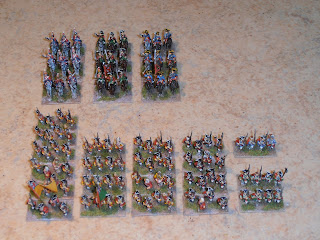The Hanoverian infantry have been painted to conform with
their new regimental details. All units wore straw coloured breeches, so that
was my first task; the change from red to straw colour.
Some changes proved less a problem as these
corresponded with the British units from which they came from. The majority of
my British troops wore either yellow, buff or green facings which were similar
to Hanoverian requirements.
There were a few oddities that certainly would compete
with a Harlequin dress at an Italian carnival festival, but luckily these were
few.
Lastly, like their British counterpart, Hannover also converged their grenadiers into temporary battalions. Hannover fielded three such units and these need to be ordered on Blue Moon
(Old Glory UK) in a week or two.
Of the seven brigades listed below some show only two
battalions of Hanoverian. These do not reflect the entire brigade strength as they list troops from Hesse-Kassel or Brunswick.
Photo one
von Block Brigade
Druchtleben (1 bn), Knesebeck (1 bn), Scheither (1
bn), Buckeburg (1 bn),
Sachsen-Gotha (1 bn), Stolzenberg (1 bn), Post
(1 bn)
von Sporcken Brigade
Jung-Zastrow (1
bn), Diepenbroick (1 bn)
von Kielmansegg
Brigade
Kielmannsegg (1
bn), Oberg (1 bn), Garde (2 bns)
Photo two
von Hodenberg
Brigade
Wagenheim(1 bn), Hodenberg (1 bn)
Detachment around
the Afferde Watchtower under von Ledebur
Ledebour (1 bn), Fabrice (1 bn)
Detachment on the
Schecken Height
between Afferde and Diedersen under Breidenbach
Sporken (1 bn),
von Hardenberg (1 bn), Zandre de Caraffa (1 bn)
Detachments near
Hameln
Kommandierte Infanterie (2,000 men) converged from
various regiments,
1st Garrison Battalion (1 bn)
Brigade von Behr
Hanoverian Brunck(1 bn), Hanoverian Block(1 bn)
To be ordered:
von Hardenberg Brigade of converged
grenadiers
Hanoverian
Grenadiers (2 bns)
von Schulenburg Brigade
Hanoverian
Grenadiers (1 bn)
Flags
I add four or five regimental flags to the Hanoverians
and two colonel colours for the Hanoverian Generals Zastrow and Kielmansegg.
The flag here is of a colonel’s flag for Hanover. (Kronoskaf.com/Hannover)
Cheers,









